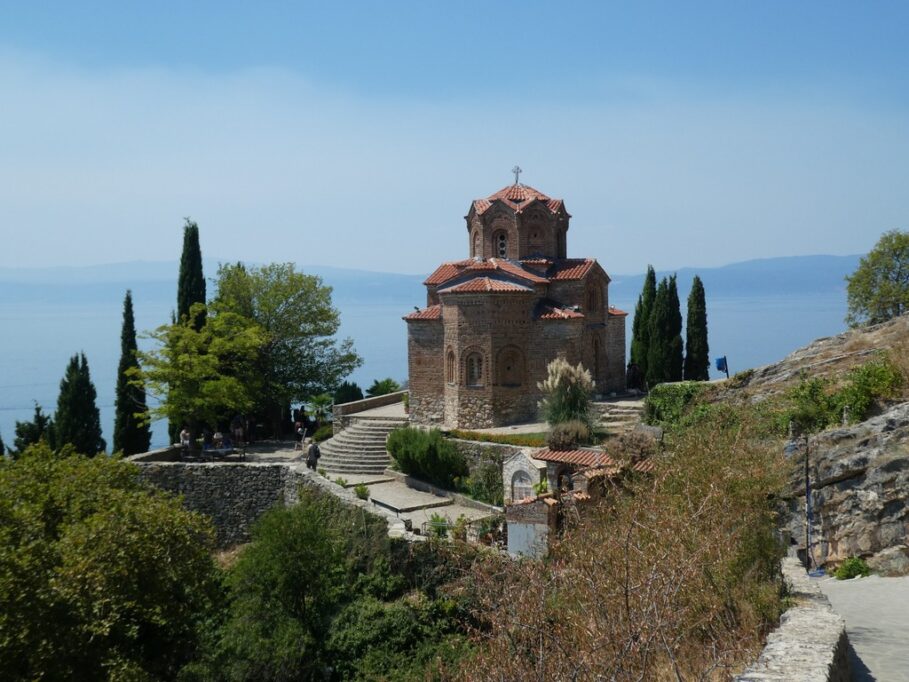OHRID
NORTH MACEDONIA
Discover our travel adventures in Ohrid, North Macedonia — a charming lakeside town rich in history and culture. From exploring ancient sites and enjoying local cuisine to relaxing by the lake, join us as we recount our memorable experiences in this picturesque destination
Ohrid: North Macedonia Stories
We had a wonderful time in Kavala, Greece, but after a month, it was time to move on. We decided to head toward Ohrid, a small town on the bank of Lake Ohrid. We chose Ohrid for a few reasons. First, we needed to leave the Schengen zone for a while. Although we are French residents, Brexit meant we lost our right of movement, so we must comply with the 90/180 day rule when traveling outside France into the parts of Europe governed by the Schengen Agreement. Second, we were keen to see more of North Macedonia, and I had heard Ohrid was a nice place to spend some time.
Ohrid isn’t actually that far from Kavala; however, there is no direct route. In the end, we had to take a bus from Kavala to Thessaloniki, change bus stations, and then get a bus to Skopje, the capital of North Macedonia. It took hours to get through the Greece/North Macedonia border, and by the time we reached Skopje, it was late, and we were hot, tired, and hungry. We checked into a hotel right on the main Alexander Square and went to dinner at a lovely restaurant, Bocata, on the square overlooking the enormous statue of Alexander the Great. We had an excellent meal and enjoyed a delicious bottle of local red wine. The service was excellent, and I highly recommend the restaurant. It was a warm, balmy evening, and families strolled through the square. I grew to really like Skopje and hope to visit again in the not-too-distant future.
We were up early the next morning, and after a quick breakfast and a trip to the square for a few sunrise photos, we headed back to the bus station to catch the bus to Ohrid.
The bus trundled through the countryside and up and down the mountains. We were traveling on a long weekend, so it was very busy, and the journey seemed to go on forever. Finally, we arrived in Ohrid and caught a taxi to our apartment.
The apartment was lovely—brand new and very well set up with everything we could possibly want. Our balcony view looked out across fields toward Lake Ohrid and the mountains of Albania in the distance.
Ohrid (and North Macedonia in general) reminded me of Turkey with touches of Southeast Asia in terms of its development and infrastructure. I liked it very much.
The hot weather continued, with most days well above 35 degrees— which is to be expected in this part of the world.
Ohrid was very low-key, popular with locals who come here for their summer holidays, camping by the lake or staying in a holiday house. Once again, we barely heard a native English speaker—exactly as we like it.
We spent a month in Ohrid, visiting the old town several times, the fort set high on the hill, and the famous Church of St. John. We spent a couple of days lounging on the “beach” and strolled along the waterfront.
We dined in a few restaurants, and while Macedonian food is nice, it’s mostly BBQ and things cooked on sticks with salad. Tasty, but not much variety. However, the local wine was exceptional, both the red and the rosé.
We also took the opportunity to work on the projects we started earlier in our travels.
After a month, it was time to move on. We enjoyed our time in Ohrid. Would I come back? Maybe.
Join us next in Athens…
Ohrid History
Ohrid, located on the western shore of Lake Ohrid in North Macedonia, is a city with a rich history that dates back to antiquity. Founded as a settlement by the ancient Illyrians, it was known as Lychnidos during the Greek and Roman periods. Ohrid’s strategic position on the lake made it a significant center for trade and culture in the region.
Under Roman rule, Ohrid thrived as a major city and continued to flourish during the Byzantine era. It became an important center for Orthodox Christianity, renowned for its numerous churches and monasteries. The city’s religious significance was highlighted by the establishment of the Ohrid Archbishopric in the 9th century, which played a crucial role in the Christianization of the Slavic peoples.
In the 14th century, Ohrid fell under Ottoman rule, during which it retained its cultural and religious significance despite the changes in governance. The city’s historical architecture, including the impressive Church of St. John at Kaneo and the medieval fortress, reflects its rich past.
Today, Ohrid is celebrated for its historical and cultural heritage, attracting visitors with its well-preserved ancient sites and stunning natural beauty. The city is also recognized as a UNESCO World Heritage site for its unique blend of cultural and historical treasures.



